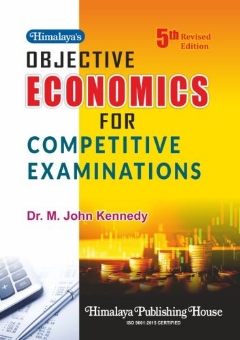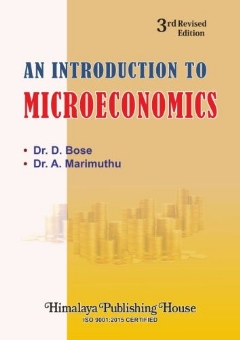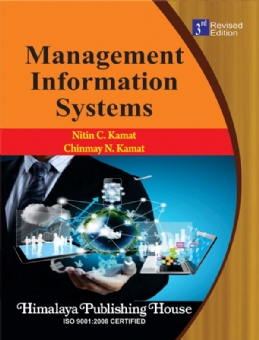This book is “Objective Economics For Competitive Examinations” designed to provide an in-depth knowledge in various branches of Economics. The multiple choice questions in this book would serve to enhance one`s knowledge in the field of economics. This book is highly useful for students preparing for various competitive examinations like NET, SET, IAS, IES and examination of all sorts in economics. Apart from this, it will also be useful for regular university and college level examinations. This book will help the students to improve their self-confidence in facing the examinations by way of self-examination.
SALIENT FEATURES
– All major branches of economics are fully covered.
– All objective type pattern questions are framed to help the students to perform boldly in examinations.
– More than 6,000 questions, covering the various aspects, from the origin of economics to recent developments like globalization and WTO.
– Answer key is also provided.
Contents :
1. MICROECONOMICS
PART – 1 : INTRODUCTION
1. Definition of Economics
2. Methods and Nature of Economic Laws
3. Microeconomics
4. Economy – Its Vital Processes and Basic Problems
5. Concept of Equilibrium
6. Economic Statics and Dynamics
PART – 2 : THEORY OF CONSUMER BEHAVIOUR
7. Law of Demand
8. Cardinal Utility Theory
9. Ordinal Utility Theory
10. Consumer’s Surplus
11. Elasticity of Demand
12. Revealed Preference Theory
13. N-M Utility Theory — Decision Making under Uncertainty — Attitude towards Risk
14. Hicks Logical Ordering Theory of Demand
PART – 3 : THEORY OF PRODUCTION
15. Factors of Production
16. Scale of Production
17. Theory of Production Function
18. Iso-quants
19. Linear Programming
20. Input-Output Analysis
PART – 4 : THEORY OF PRODUCT PRICING
21. Cost and Cost Curves
22. Revenue and Revenue Curves
23. Law of Supply
24. Objectives of Business Firms
25. Market and Market Structure — Competitive and Non-competitive Equilibria
26. Equilibrium of the Firm and Industry – General
27. Equilibrium of the Firm and Industry – Under Perfect Competition and Monopoly
28. Pricing under Perfect Competition
29. Monopoly
30. Price Discrimination
31. Monopsony and Bilateral Monopoly
32. Monopolistic Competition
33. Contestable Market
34. Duopoly
35. Oligopoly
36. Game Theory
37. Alternative Theories of Firm
PART – 5 : THEORY OF FACTOR PRICING
38. Distribution
39. Rent
40. Wages
41. Interest
42. Profit
43. Classical Theory of Value
PART – 6 : WELFARE ECONOMICS
44. Neo-Classical Welfare Economics
45. Paretian Welfare Economics
46. Compensation Criteria
47. Social Welfare Function
48. Arrow’s Theory of Social Choice
49. Market Failure and Externalities — Coase Theorem
50. The Economics of Information — Asymmetric Information, Adverse Selection and Moral Hazard — Fundamental Theorems of Welfare Economics
2. MACROECONOMICS
PART – 1 : INTRODUCTION
1. Definition of Macroeconomics
2. Basic Concepts in Macroeconomics
PART – 2 : CIRCULAR FLOW AND NATIONAL INCOME
3. Circular Flow of Income
4. The National Income and its Distribution: Concepts and Measurement
PART – 3 : MACROECONOMIC THEORY: DETERMINATION OF OUTPUT AND EMPLOYMENT
5. The Classical Theory of Employment
6. Say’s Law of Market
7. The Keynesian Theory of Income and Employment
8. The Multiplier
9. Balanced Budget Multiplier and Foreign Trade Multiplier
10. The Acceleration Principle
11. Super Multiplier
12. Consumption Function
13. Theories of Consumption Function
14. Savings and Investment
15. Rate of Interest
16. Keynes’ Theory of Money and Prices
17. Evaluation of Keynesian Theory of Employment
PART – 4 : MONETARY THEORY
18. IS-LM Production Function: General Equilibrium
19. Inflation and Theories of Inflation
20. The Phillips Curve
21(a). Demand for Money and Supply of Money
21(b). Keynesian Economics
PART – 5 : THEORIES OF BUSINESS CYCLE
22. Business Cycles
23. Some Alternative Theories of Business Cycle
PART – 6 : MACROECONOMIC POLICY AND THEORIES OF DISTRIBUTION
24. Objectives of Macroeconomic Policy
25. Monetary Policy
26. Fiscal Policy
27. Income Policy
28. Rational Expectations Hypothesis and its Critique
29. Monetarism vs. Keynesianism
30. Supply Side Economics
31. New Classical Macroeconomics
32. Macro Theories of Distribution
3. MONEY AND BANKING
PART – 1 : INTRODUCTION
1. Evolution and Functions of Money
2. Monetary Standards, Near Money and Present Monetary System
PART – 2 : THEORIES OF MONEY
3. Quantity Theories of Money and Its Variants
4. Friedman’s Restatement of the Quantity Theory of Money
5. Patinkin’s Integration of Monetary and Value Theory
6. The Liquidity Theory of Money
7. The Demand for Money and Supply of Money
PART – 3 : BANKING
8. Commercial Banks and Nationalization
9. Central Bank
10. Inflation and Deflation
11. Business Cycles
PART – 4 : FINANCIAL INSTITUTIONS AND POLICIES
12. Money and Capital Markets
13. Monetary Policy – Objectives, Targets and Indicators
14. Fiscal Policy and Debt Management
15. Non-Banking Financial Intermediaries
PART – 5 : INTERNATIONAL FINANCIAL INSTITUTIONS
16. IMF, IBRD, IDA, IFC and ADB
4. PLANNING AND DEVELOPMENT
PART – 1 : MEANING OF PLANNING AND DEVELOPMENT
1. Introduction
PART – 2 : THEORIES OF ECONOMIC DEVELOPMENT
2. Major Development Theories — Adam Smith, Ricardo, Marx, Schumpeter, Rostow, Balanced and Unbalanced Growth, Big Push
PART – 3 : GROWTH MODELS
3. Major Growth Models — Harrod-Domar, Solow, Robinson, Kaldor, etc.
PART – 4 : DOMESTIC MEASURES FOR ECONOMIC DEVELOPMENT
4. Domestic Measures
PART – 5 : INTERNATIONAL MEASURES FOR ECONOMIC DEVELOPMENT
5. International Measures
PART – 6 : PROBLEMS OF DEVELOPMENT AND PLANNING
6. Major Problems of Development
PART – 7 : ISSUES IN PLANNING AND DEVELOPMENT
7. Major Issues in Planning and Development
5. INTERNATIONAL ECONOMICS
PART – 1 : THE PURE THEORY OF INTERNATIONAL TRADE
PART – 2 : COMMERCIAL POLICY
PART – 3 : BALANCE OF PAYMENTS
PART – 4 : INTERNATIONAL ECONOMIC RELATIONS
PART – 5 : OPTIMUM CURRENCY AREA
PART – 6 : INTERNATIONAL MONETARY SYSTEM
6. PUBLIC FINANCE
PART – 1 : INTRODUCTION
1. Meaning and Scope of Public Finance – Economic Activities and the State — Public Goods, Externality
2. Principle of Maximum Social Advantage
3. Types of Taxes – Public Revenue – Classification of Taxes – Canons of Taxation
PART – 2 : THEORIES ON TAXATION AND EXPENDITURE
4. Theories of Taxation – Incidence of Taxes – Taxable Capacity – Effects of Taxation
5. Public Expenditure – Theories – Effects
6. Public Debt and Debt Burden
7. The Public Budget and Public Undertakings
PART – 3 : FEDERAL FINANCE
8. Federal Finance
9. Local Finance
10. Deficit Financing and Fiscal Policy
7. INDIAN ECONOMY
PART – 1 : STRUCTURE OF INDIAN ECONOMY
1. Colonialism and Nature of Indian Economy
2. Natural Resource and Ecological Issues — Valuation of Environmental Goods
3. Infrastructure
4. The Population Problem — Theories of Population — Concept and Measures: Fertility — Morbidity — Mortality — Age Structure — Demographic Dividend — Life Table
5. Human Resource Development
6. Labour Force Growth, Participation and Occupation Pattern
7. Trends and Structure of Employment
8. Capital Formation in India
9. National Income of India
10. Poverty and Income Distribution in India
PART – 2 : BASIC ISSUES IN AGRICULTURE
11. Indian Agriculture: Role, Nature and Cropping Pattern
12. Issues in Indian Agricultural Policy and Rural Development
13. Agricultural Production and Productivity Trends
14. Land Reforms
15. Agriculture Inputs and Green Revolution
16. Agricultural Finance and Marketing
17. Agricultural Subsidies and Food Security in India
18. Agricultural Labour
PART – 3 : INDUSTRIAL DEVELOPMENT AND RELATED ISSUES
19. Industrial Development during Planning Period
20. Major Industries of India
21. Small-scale and Cottage Industries
22. Industrial Policy
23. Public and Private Sector in India
24. Industrial Sickness in India
25. Labour Relations, Social Security and Exit Policy
PART – 4 : FOREIGN TRADE AND FOREIGN CAPITAL
26. India’s Foreign Trade and Balance of Payments
27. Foreign Capital and Forex Reserves
28. Multinational Corporations
29. Globalization
30. WTO and India
PART – 5 : MONEY AND BANKING
31. Price Trends and Inflation
32. Indian Money Market and Capital Market
33. Commercial Banking in India
34. The Reserve Bank of India
35. Institutional Financing
PART – 6 : PUBLIC FINANCE
36. The Indian Tax Structure
37. Public Expenditure in India
38. Public Debt in India
39. India’s Fiscal Policy
40. Federal Finance in India
PART – 7 : ECONOMIC PLANNING AND POLICY
41. Economic Planning and Strategy
42. Regional Planning in India
43. Economic Reforms and Liberalization
44. Other Issues Related with Indian Economy







